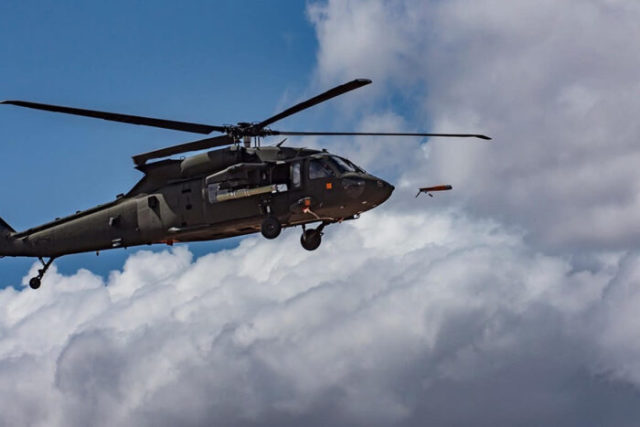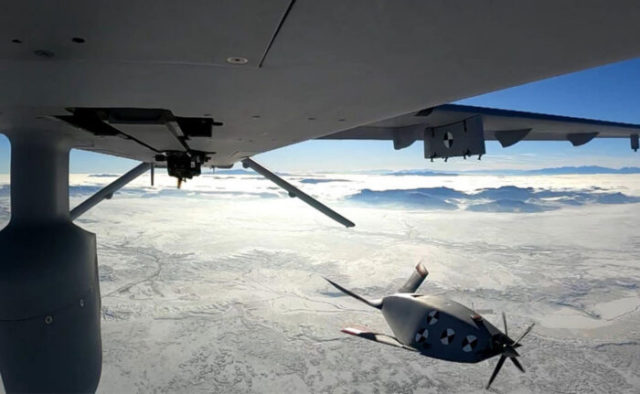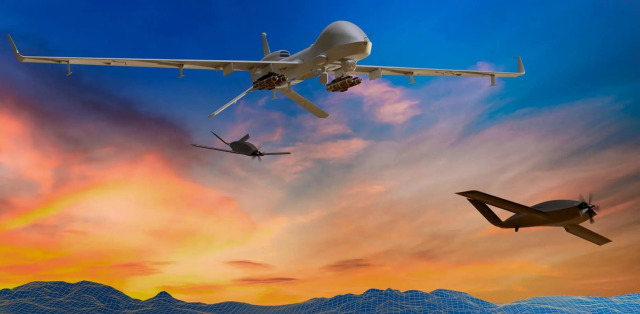As noted earlier, foreign armies are armed with numerous categories of conventional air-to-ground munitions (AGM) of the air-to-ground class. In the first part of the article , a group of guided aerial bombs is considered. The second part tells about air-launched missiles. This publication completes the material and presents a new concept for the use of unmanned air-based systems.
Air-based effectors
Air Launched Effects (ALE) is a new concept designed to equip manned helicopters and UAVs with flexible air-to-ground weapons. ALE is mainly used by the US Armed Forces , especially the army. They will eventually be used in a variety of sizes and models, with larger types having greater payloads and characteristics, including a range of several hundred kilometers. These multi-purpose effectors can be used as reconnaissance equipment (including guidance beyond the line of sight for long-range artillery), shock munitions, communication nodes, or as electronic warfare or electronic warfare (EW) equipment.
ALE tools can be used singly or in swarms, ensuring coordinated saturation of airspace sectors. Tactical advantages include extending the range of the aircraft's sensors and hitting targets, while the aircraft remains out of range of detection or defeat of enemy air defenses. They are designed to be relatively inexpensive and affordable for purchase and expenditure/combat use in large quantities.
Despite the fact that air-based effectors are of interest for use on modern combat aircraft, the US Army pays special attention to ALE as an element of multiplying the strength of the future "ecosystem" within the framework of the Future Vertical Lift program. The latter should include promising long-range attack helicopters (Future Long Range Assault Aircraft, FLRAA), promising reconnaissance and attack helicopters (Future Attack Reconnaissance Aircraft, FARA) and a future Tactical Unmanned Aerial System (FTUAS).
US Army ALTIUS Effector
Currently, the US Army is experimenting with the first aerial prototype of a tactically integrated unmanned flexible/universal launch system (Agile Launched, Tactically Integrated, Unmanned System, ALTIUS). The ALTIUS production group is headed by a subsidiary of Anduril AREA-I (USA), which also supplies the aircraft. Tests of the ALE launched from the tube are conducted from UH-60/MH-60M helicopters and Gray Eagle UAVs, although it can also be used with AC-130J and Valkyrie XQ-58 drone. ALTIUS has greater endurance and payload capacity than most UAVs of comparable size.
The original ALTIUS is a derivative of the AREA-I Altius 600 drone. The wings of the drone, starting from the launch container (pipe), open after launch, reaching a three-meter span. The case diameter is 15.3 cm, the exact length is still classified. The payload is 3.2 kg, the flight time reaches four hours, and the flight range is about 450 km. Anduril launched a larger version of ALE, under the ALTIUS-700M index, in 2021. It is believed that due to the flight range of 500 km and a warhead weighing 15.9 kg, this model will expand the set of targets to include heavily armored vehicles and artillery systems.

Test launch of the ALTIUS 600 air-based effector from a UH-60 helicopter
One operator can control several drones. A high level of autonomy reduces the burden on the operator, facilitating teamwork and coordinated strikes. Major General Wally Rugen, head of the Army's cross-functional aviation group, said in May 2023 that the service prefers a "wolf pack" network approach, in which one drone acts as a leader and others perform specific tasks that contribute to achieving the overall goal of the swarm.
The army demonstrated this capability in April 2022 by launching four consecutive swarms of seven ALTIUS-600 barrage ammunition (BB) each. A combined swarm of 28 drones was formed, which began searching for and destroying simulated ground targets. In addition, the UAVs, controlled by a single operator, transmitted updated tactical intelligence data to the arriving airborne forces before they reached the landing zone.
According to the army's budget documents, the service adheres to a phased approach that allows rapid prototyping and commissioning of technology as it becomes viable, while continuing engineering efforts to develop and implement additional capabilities. This is achieved through parallel and/or sequential development, simulation, and physical prototyping of the aircraft, payload, and flight control system architecture. Evaluation of the prototype should continue until fiscal year 2024, while the army clarifies its requirements and initial concept of operations. The budget documents indicate that the request for proposals is scheduled to be published at the end of fiscal year 24, and the contract for the design and development of production is scheduled to be concluded in the third quarter of fiscal year 25.
General Atomics Eaglet
Meanwhile, General Atomics Aerial Systems (USA) is developing its own air-based effector, called Eaglet ("Eaglet"). The product is primarily designed to be launched from a larger UAV, helicopter or ground vehicle. For the first time, the prototype Eaglet was launched from the army-owned General Atomics Gray Eagle UAV in January 2023. Devices such as the Grey Eagle can transport ALE thousands of kilometers before using it, providing deep penetration into enemy territory. The Eaglet is considered primarily as a means of reconnaissance and electronic warfare, with additional usefulness as a command and control node for deep penetration.

Eaglet launch from the US Army MQ-1C Gray Eagle Drone
U.S. Navy Developments
The U.S. Marine Corps is also experimenting with effectors. As part of the Armed Forces modernization program until 2030, the Corps plans to exchange part of its arsenal of Hellfire missiles for an "inexpensive family of air-based flying ammunition." The main incentive is the significant advantage in firing range provided by some BB. "This is an ability that extends over hundreds of kilometers, and it allows us to use a modern platform to do things we never thought we could," said Brigadier General Stephen Lightfoot, director of the U.S. Navy's Directorate of Capability Development. Lightfoot predicted that the effectors would be put into operation "within the next few years."
Based on the materials of the resource euro-sd.com

